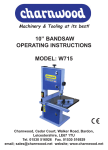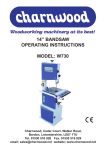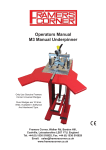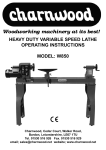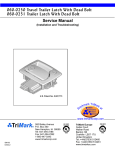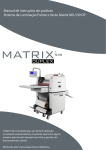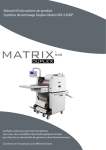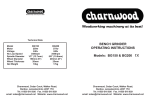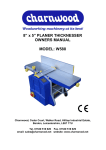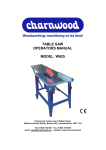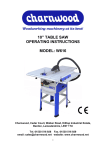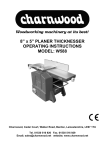Download 8” BANDSAW OPERATING INSTRUCTIONS MODEL: W711
Transcript
Machinery & Tooling at its best! 8” BANDSAW OPERATING INSTRUCTIONS MODEL: W711 Charnwood, Cedar Court, Walker Road, Bardon, Leicestershire, LE67 1TU Tel. 01530 516926 Fax. 01530 516929 email; [email protected] website; www.charnwood.net GENERAL SAFETY RULES WARNING: Do not attempt to operate the machine until you have thoroughly read and understood completely all instructions, rules, etc. contained in this manual. Failure to comply may result in accidents involving fire, electric shock, or serious personal injury. Keep this owner's manual and review frequently for continuous safe operation. 1. Know your machine. For your own safety, read the owner's manual carefully. Learn its application and limitations, as well as specific potential hazards pertinent to this machine. 2. Make sure all tools are properly earthed. 3. Keep guards in place and in working order. If a guard must be removed for maintenance or cleaning, make sure it is properly replaced before using the machine again. 4. Remove adjusting keys and spanners. Form a habit of checking to see that the keys and adjusting spanners are removed from the machine before switched it on. 5. Keep your work area clean. Cluttered areas and workbenches increase the chance of an accident.' 6. Do not use in dangerous environments. Do not use power tools in damp or wet locations, or expose them to rain. Keep work areas well illuminated. 7. Keep children away. All visitors should be kept a safe distance 8. from the work area. 9. Make workshop childproof. Use padlocks, master switches and remove starter keys. 10. Do not force the machine. It will do the job better and be safer at the rate for which it is designed. 11. Use the right tools. Do not force the machine or attachments to do a job for which they are not designed. Contact the manufacturer or distributor if there is any question about the machine's suitability for a particular task. 12. Wear proper apparel. Avoid loose clothing, gloves, ties, rings, bracelets, and jewellery which could get caught in moving parts. Non-slip footwear is recommended. Wear protective hair covering to contain long hair. 13. Always use safety glasses. Normal spectacles only have impact resistant lenses. They are not safety glasses. 14. Do not over-reach. Keep proper footing and balance at all times. 15. Maintain the machine in good condition. Keep the machine clean for best and safest performance. Follow instructions for lubrication and changing accessories. 16. Disconnect the machine from power source before servicing and when changing the blade. 17. Never leave the machine running unattended. Turn the power off. Do not leave the machine until it comes to a complete stop. 18. Do not use any power tools while under the effects of drugs, alcohol or medication. 19. Always wear a face or dust mask if operation creates a lot of dust and/or chips. Always operate the tool in a well ventilated area and provide for proper dust removal. Use a suitable dust extractor. ADDITIONAL RULES FOR BAND SAWS 1. Ensure that the saw table is clear of off-cuts, tools or anything else that might foul the work-piece. 2. When cutting long boards use one or more roller stand(s) to support the work or have a competent helper to support it as it feeds off the rear of the table. 3. Always make sure that the blade is tracked and tensioned correctly before starting to use the saw. 4. Always use a brush to clear the table of dust or debris. NEVER use your hands, especially when the machine is running. 5. Always ensure that the thrust bearings and guide blocks are correctly adjusted before using the saw. 6. ALWAYS USE A PUSH STICK WHEN IT IS NECESSARY TO PUSH ANY PIECE OF MATERIAL OF SUCH SIZE THAT IT WOULD BRING YOUR HANDS WITHIN 30 CM OF THE BLADE. 7. Do not cut material that is badly warped or which has screws or nails in it. 8. Be extra vigilant when cutting stock which has loose knots in it as these my fly out of the saw. 9. NEVER tilt the table when the saw is running. 10. To avoid exposure to hazardous dust, do not use this saw without connecting it to a suitable dust extractor. 11. Always work with a sharp saw blade and feed the work at a rate suited to the thickness and hardness of the material. Note: This band saw has been designed and built solely as a woodworking machine. Do not modify it in any way or use it for anything other than its designated purpose. Neither the manufactures nor the supplier are liable for any damage or injury caused by incorrect assembly, operation or electrical connection of this machine. Specification Table size Motor Blade length Blade speed (no load) 300 x 300 mm 300W 1400 mm 1400±10% m/min Maximum depth of cut at 90o 80mm Maximum depth of stock at 45o 56mm Throat capacity Dust extractor hose connection Weight Features Precision ground, aluminium table with integrated scale 0 to 45o table tilt 200mm 40mm 15kg net/17kg gross High Quality, British made blade Easily portable machine Direct drive (no drive belts to stretch or wear) Quick release, positive lock rip fence Cross cut/mitre fence with easily read scale Tool free blade tracking and tensioning Unpacking After cutting the tape at the top of the box, invert it on a table or bench and lift it off the polystyrene insert. Separate the two pieces of packing and remove all the components. Assembly Invert the table and remove the hex headed bolt and the blade retainer. Place the saw, so that it is lying on its back. Prop the upper end up on a suitable block or box, so that the table may be held in place with the four threaded holes in line with the holes in the upper trunnion. Using the four bolts and serrated washers supplied, bolt the table to trunnion, tightening the bolts after all four have been fitted. Refit the blade retainer. Check to see if the blade is centred in the slot. You will probably find that it is offset to one side or the other. The slot is considered to be the narrower dimension, i.e. the same as the slot in the metal. The wider gap in the insert allows for 45° cutting. The lower trunnion is attached to the body of the saw by three hex headed bolts. These may be slackened and the trunnion slid in either direction until the blade is centred. After adjustment, tighten them securely. Adjustable pointer. This lever locks and unlocks the trunnion so that the table may be tilted. Having set the table so that the blade is centred, use a set square position the table at right angles to the blade. Lock it in position and if necessary, adjust the pointer so that it aligns with the zero as shown above. Tilt the table to 45° and insert the level stop screw, complete with locking nut, into the tapped hole on the top face of the saw’s lower housing. Reset the table to 0° and adjust the level stop screw so that it touches the underside of the table. Secure it in this position with the locknut. Screw in and lock the push stick hanger on the back of the frame. This completes the assembly of your saw. Setting up your saw Blade tensioner Blade guard positioner and lock Tracking control and lock Adjust the blade tension by hand wheel on top of the upper housing. ‘Pluck’ the back of the blade, as you would the string of a double bass, at this point. As the blade tension is increased, the pitch of the sound will rise. Stop increasing the tension as soon as the sound starts to become dull. Alternatively, raise the blade guard to its highest position and adjust tension until the blade, at the midpoint between table and guard can be deflected only 3 to 5 mm with finger pressure. Turn the upper wheel clockwise, by hand and adjust the tracking control until the blade is centred on the wheel, as shown in the inset illustration. Lock the adjuster in this position. The upper and lower thrust bearings and guide pins should be set up next. Thrust bearing Guide pin Guide pin locking screw The thrust bearing should be about 0.5 mm behind the back of the blade. Adjust it and lock it place. Slacken the guide pin locking screws, push the pins in until they touch the blade. Rotate the top wheel by hand a few turns and lock the pins in the position they have assumed. The lower thrust bearing is adjusted similarly. Lower thrust bearing Locking screw Blade guard Blade guard fixing bolt The blade guard fixing bolt is slackened and the guard swivelled to one side for blade changing. This bandsaw is equipped with a rip fence and a cross cut/mitre fence which can be fitted as shown. The rip fence may be used as a length stop for repetitive cross or mitre cuts. Your bandsaw is now ready for use, but it is recommended that it be bolted to a bench and that a suitable dust extractor be fitted. Changing the blade Bandsaw blades are sharp enough to cause injury even when too blunt to cut wood! It is recommended that protective gloves be worn when handling blades. Unplug the bandsaw from the mains socket, slacken off the blade tension and open the upper and lower housing doors with the aid of a suitable screwdriver. Remove the blade retainer from the table. Loosen the bolt and swing the lower blade guard out of the way. Lower the upper blade guide Slide blade off upper and lower wheels, bringing it out of the machine via the slots in the rear frame and the blade guard. Reverse these steps to fit the new blade. Ensure that the teeth are at the front and pointing down. Position the blade between the guide pins. Tension and adjust the tracking as done during the initial set up. Check and adjust, if necessary, the position of the two thrust bearings and the guide pins. W711 Parts List Item 1 2 3 4 5 6 7 8 9 12 13 14 15 16 17 18 19 20 21 22 23 24 25 26 27 28 29 30 31 32 33 34 35 36 37 38 39 40 41 42 43 44 45 46 47 48 49 50 51 Rip fence Scale Table Table insert Lower trunnion Upper trunnion Pointer Guide piece Coach bolt Nut Locking pin Thrust bearing shaft Upper guide housing Cap head setscrew Guide pin Thrust bearing Cap head setscrew Cap head setscrew Self tapping screw Upper guide seat Guide lever Coach bolt Shaft Cover board Slide board Lower guide pin Lower guide housing Rack Hex. head bolt Spring washer Tyre Lower wheel Blade Hex. head bolt Latch Nut Lower door Washer Latch housing Slotted insert Washer Bolt Upper door Circlip Upper wheel Coach bolt Brush Spacer NVR switch Part Quantity 1 1 1 3 1 1 1 1 1 4 1 2 1 4 2 2 2 1 4 1 1 1 1 1 1 2 1 1 8 4 2 1 1 8 2 2 1 2 2 2 4 7 1 1 1 1 1 1 1 52 53 54 55 56 57 58 59 60 61 62 63 64 65 66 67 68 71 72 73 74 75 76 77 78 79 80 81 82 83 84 85 86 Screw Switch plate Upper bearing bolt Bearing Gasket Upper bearing bolt support Flanged nut Blade tensioner Guide plate assembly Guide pin Guide piece Hex. head bolt Flanged nut Coach bolt Lower blade guard Lock nut Hex. head bolt Motor Locking knob Mains cable and plug Upper blade guard positioning knob Spring Cover Washer Tension control knob Hex. head bolt Wing nut Spring Shaft Threaded rod End cap Frame Nut Serrated lock washer 2 1 1 2 1 4 1 1 1 1 1 1 2 1 2 5 1 1 1 1 1 1 4 2 1 1 9 1 1 1 1 1 2













